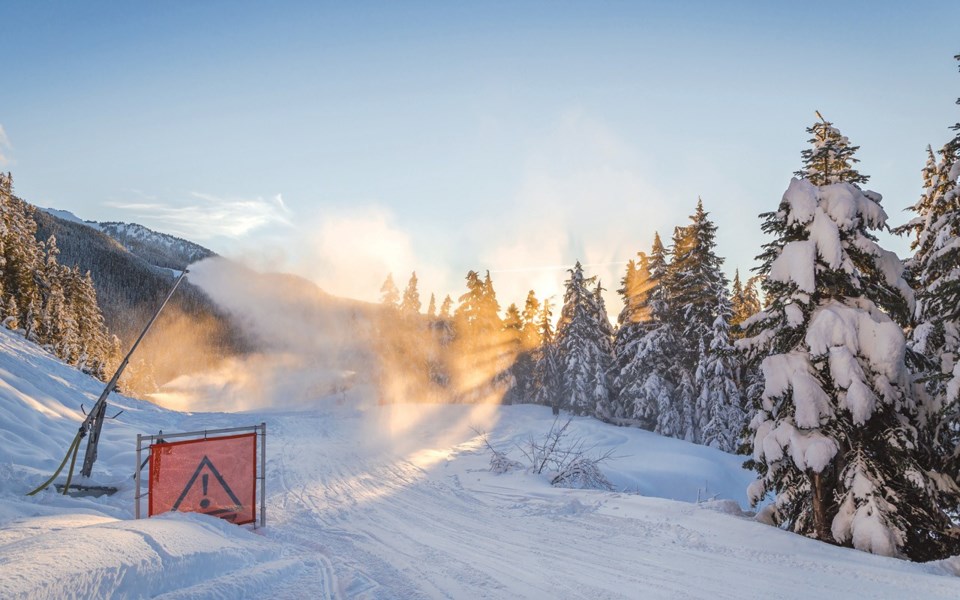With climate change resulting in more variable conditions at ski resorts the world over, resort operators are increasingly turning to snowmaking machines to complement what naturally falls from the sky.
And while the snowmaking manufacturing industry hums along, environmentalists are increasingly raising concerns about both the amount power and water snowmaking equipment utilizes.
The trend towards purchasing snowmaking equipment is alive and well in B.C., though the province's resorts were years behind their counterparts back east when it came to making the investments, explained Blake Butler, a PhD candidate in history at the University of Western Ontario.
"It's a business decision at the end of the day," said Butler, whose research looks at the history of snowmaking at Canadian ski resorts. "Without snow, you can't ski, and for resorts, that's a loss of revenue." The loss, he added, isn't confined to just the operators, as all of the adjacent businesses—think tourist operators, retailers and restaurants—also suffer. "Average winter temperatures are rising and are expected to continue to rise while annual snow falls are expected to decline in the future," said Butler. "So for a lot of ski resorts, having snowmaking equipment is going to become even more important. But on the flip side ... people are becoming more aware of the environmental impact of it."
The problem, however, isn't lost on North American ski resorts, which are increasingly under the microscope for their heavy carbon footprint.
According to Allana Williams, senior manager of sustainability for Whistler Blackcomb (WB), the resort has made significant strides in lessening the environmental footprint of its snowmaking equipment, investing in energy-efficient infrastructure and sophisticated computer equipment that results in energy savings.
WB recently purchased 20 low-energy snowmaking guns that use between 10 to 30 per cent of the amount of energy as a traditional snowmaking gun, she explained.
Of the resort's 338 guns, 81 are now low-energy, she said.
WB's new low-energy guns perform best in colder conditions, said Williams, and are therefore well suited for mid-mountain, whereas the older guns are better for warmer conditions (near the base).
She added that WB—which has a stated goal of being zero waste, zero-carbon and zero net emissions—has lessened its electrical footprint in recent years. "In the 2018 calendar year, we used less electricity on mountain than we did in 2005," said Williams, noting that that was the year that WB began working with BC Hydro on energy retrofits.
It is also important to remember that B.C. operates predominantly from a renewable energy source in terms of hydro-electric power, added Marc Riddell, WB's communications director.
"We operate primarily off renewable energy," he said.
WB's parent company, Vail Resorts, has also got on board with the energy-saving game of late, making a significant investment in wind energy to offset its carbon footprint.
The operator signed a "virtual-power purchase agreement" last year, said Williams. "So essentially, we are investing in a wind farm [that] is putting enough wind power [out so] that it equals the whole North American electrical consumption for all North American resorts in 2019."
Snowmaking equipment, however, continues to be a huge draw when it comes to water usage.
And while WB did not share how much water it takes to produce snow, Grouse Mountain reported on its website that it takes about 180,000 gallons (681,374 litres) of water to cover one acre with one foot (30 centimetres) of snow.
And in Jan. 2014, Pique reported that WB had converted approximate 265 million gallons (about 1 billion litres) of water to snow that season, effectively salvaging the money-making winter holidays for visiting tourists and justifying $60 million in snowmaking infrastructure spending.
Baker said that while he hasn't heard much in terms of opposition to snowmaking in Canada, that has been a much more significant issue in the U.S., even leading to some lawsuits against ski resort operators.
"In the '60s and the '70s, some resorts were a little wary about snowmaking but a lot of people jumped on them pretty quickly," he said. "I think it's once [snowmaking equipment has] been in place for a while and people become more comfortable with [it], that they start to say, 'but where are we getting the water and energy from?'"
Christopher Nicolson, head of the Canada West Ski West Areas Association, said that snowmaking represents one adaptation that resorts are making because of climate change, along with other initiatives to be more environmentally friendly.
"There are more ski resorts investing in snowmaking. But there are a variety of motivations for that, with competition [for] race teams and to open early," he added.
"In many areas there are higher skier counts, so you're trying to build up your base of snow in those areas so you're then able to extend your snow over a longer season."
Moreover, in years like this one—which is seeing a relatively slow start around the province—the equipment is paying off, he pointed out.
"The areas that are open have had the benefit of snowmaking," said Nicolson.




